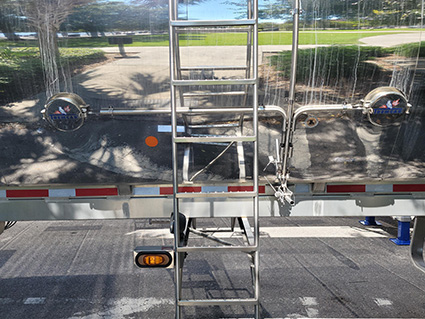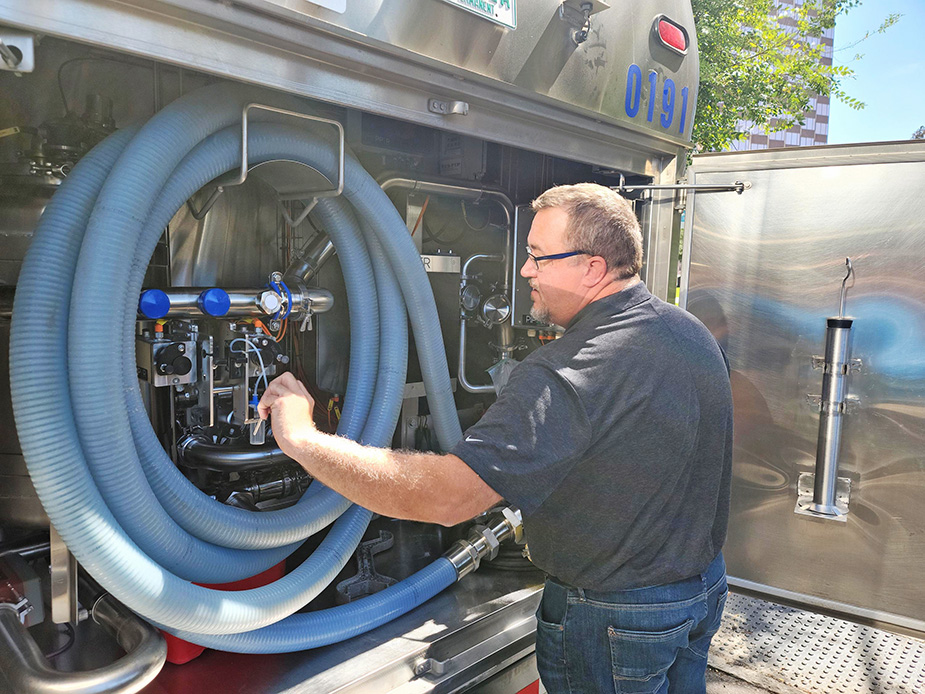Aseptic Sampling System for Tanker Trucks: Enhancing Safety and Efficiency
Compared to other industries, trucking, including the milk tanker industry, has some of the highest work-related injury and illness costs. So it makes sense to investigate a safer aseptic sampling system for tanker trucks to reduce risks and improve safety.
According to Safety and Health Assessment and Research for Prevention program, known as SHARP, it’s estimated for the trucking industry those costs exceed $107 million and 576,000 lost workdays annually due to on-the-job injuries.
 One of the more precarious responsibilities for a milk tanker driver is climbing atop a tanker to obtain milk samples. The addition of railings to tanker ladders helped reduce that figure, but falls, strains, and sprains are frequent occurrences. Given that drivers are climbing truck ladders hundreds of times per week, the likelihood of an accident (and claim) due to the repetitious nature of the act is significantly higher than for less frequent risky actions.
One of the more precarious responsibilities for a milk tanker driver is climbing atop a tanker to obtain milk samples. The addition of railings to tanker ladders helped reduce that figure, but falls, strains, and sprains are frequent occurrences. Given that drivers are climbing truck ladders hundreds of times per week, the likelihood of an accident (and claim) due to the repetitious nature of the act is significantly higher than for less frequent risky actions.
The key to avoiding or minimizing workplace injuries is recognizing the hazards that contribute to them, then utilizing tools and practices to protect against them. One such prevention strategy is installing QualiTru’s Adjustable Tanker Truck Port with Security Lid. It has become an effective workplace safety measure, protecting employees against injury, lowering company claims costs, and consequently increasing productivity and profits.
According to the U.S. Bureau of Labor Statistics & Occupational Safety and Health Administration’s (OSHA) Occupational Safety & Health Academy, the average number of workdays lost due to a work-related claim in the trucking industry is 19. For a full-time driver making $29/hour, a work-related injury will cost a company approximately $4,385 in lost employee time.
“The average number of workdays lost due to a work-related claim in the trucking industry is 19. For a full-time driver making $29/hour, a work-related injury will cost a company approximately $4,385 in lost employee time.” (Source: OSHA)
The average medical cost per claim for truck drivers is nearly $16,000, so businesses are looking at $20,000 as an average direct claim cost per work-related incident. However, a more accurate estimate for all lost time is closer to $40,000—the more accidents, the higher that cost.
Recognizing indirect costs
Indirect costs are all the “uninsured” additional costs associated with a workplace accident and injury. Indirect costs are often much more significant than direct costs, anywhere from two to ten times as expensive ($40,000 to $200,000). According to the National Safety Council, indirect or uninsured costs include:
- Productive time lost by an injured employee.
- Productive time lost by employees and supervisors helping the accident victim.
- Time to hire or train a worker to replace the injured worker until they return to work.
- Reduced morale among your employees, and perhaps lower efficiency.
Unlike direct costs, indirect costs are uninsured; they come right out of the corporate pocketbook and are the costs that can put a company in financial straits.
Incorporating QualiTru’s Tanker Truck Port into your fleet can reduce direct and indirect claims costs, enhancing a business’s profitability. In addition, by eliminating the need for drivers to climb up and down the truck ladder on a daily basis, the risk of employee injury is significantly reduced.
This lowers a company’s workers’ compensation experience modification factor as well. As a result, fewer claims make the business more desirable to an insurance company and more than likely more favorable for underwriting.
According to OSHA, businesses see an average return of $4 to $6 for every dollar invested into their workplace safety programs.
When a trucking company can show an insurer’s dedication to workplace safety, an attractive workers’ compensation mod factor, and key indicators toward risk management, the net result is lower premiums. The ultimate benefit is a healthier workforce and greater employee satisfaction and retention because of it.
Safer and proven aseptic sampling system for tanker trucks
Integrating QualiTru’s Adjustable Tanker Port into your fleet is a strategic investment in risk management. The QualiTru Sampling System can be adapted to automated truck sampling systems, like the Piper System, to ensure aseptic milk sampling and driver safety.

This is an example of a Tremcar trailer with a Piper load/unload system and fitted with a QualiTru stainless steel sampling port.




